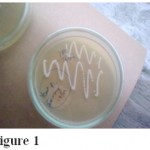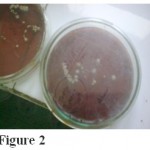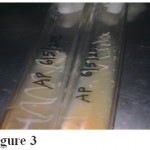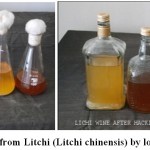Manuscript accepted on : 09-Mar-2019
Published online on: 29-03-2019
Plagiarism Check: Yes
Sonia Kumari*1, Awadhesh K. Jha2 and Anil K. Singh3
1Cum Jr. Scientist, Department of Microbiology, SGIDT, BASU, Patna.
2Cum Jr.Scientist, Department of Dairy Economics, SGIDT, Patna.
3Principal Scientist ICAR RCER, Patna.
Corresponding Author E-mail: sonia.sinhasgidt@gmail.com
DOI : http://dx.doi.org/10.13005/bbra/2726
ABSTRACT: Saccharomyces cerevisiae is common yeast of economic importance in food and brewing industries. This study aimed at isolating the yeast from local sources, viz. Toddy, Date palm toddy, Fermented dough, Fermented fruit juice of apple and orange and then characterized on the basis of their morphology, microbial count, temperature, ethanol tolerance, flocculation, and fermentative ability and on stress test, to see if they can serve as a sources for industrial purposes. Some of them were found to possess high temperature and ethanol tolerance ability, some had high flocculation and fermentative capacity and survived when subjected to various stress conditions. Saccharomyces cerevisiae isolated from these local sources can be used effectively in the bakery and brewing industries. The yeast isolated from date palm has ability to grow at low temperature, have high ethanol tolerance ability and high flocculation ability. Likewise yeast isolated from toddy has ability to grow at high temperature and also have good ethanol tolerance ability. The ability of yeast to flocculate have benefit of easy separation from the final product at the end of fermentation without filtration/centrifugation and it is a important source for bakers industry while yeast that have good ethanol tolerance ability and high temperature tolerance ability can be use in alcoholic industry from various sources.
KEYWORDS: Brewing; Date Palm; Fermented Fruit Juice; Fermented Dough; Flocculation; Saccharomyces Cerevisiae; Toddy
Download this article as:| Copy the following to cite this article: Kumari S, Jha A. K, Singh A. K. Isolation and Characterization of Temperature and Ethanol Tolerant Strain of Saccharomyces Cerevisiae Strains from Naturally Fermented Juices. Biosci Biotech Res Asia 2019;16(1). |
| Copy the following to cite this URL: Kumari S, Jha A. K, Singh A. K. Isolation and Characterization of Temperature and Ethanol Tolerant Strain of Saccharomyces Cerevisiae Strains from Naturally Fermented Juices. Biosci Biotech Res Asia 2019;16(1). Available from: https://bit.ly/2U6dSNY |
Introduction
Fermentation preserve crops and dairy product by creating an unfavorable environment for Microrganism that are responsible for spoilage. The fermented beverages and dairies industry are known since more than 3500 years.1 The organism responsible for fermentation is “Yeasts.” It was isolated from cereal based foods2,3 from various milk product4,5 or cheese.6 Correlation of yeast growth rate metabolism and concentration of ethanol was noticed by7 and optimum value noted was around 30°C. Ethanol tolerant strain of yeast have ability to increase the efficiency of ethanol production on an industrial scale.8 Selection of ethanol tolerant microorganism by allowing fermentation at high temperature.9 Ethanol and thermo-tolerant strains can be isolated from natural resources such as soil, water, plants, and animals. So the present investigation aims at the isolation, characterization and selection of a suitable Saccharomyces cerevisiae strains from local toddy, Date palm and other fermented fruit juices as well as to assess their ability to tolerate the high temperature and high alcohol content prevailed during fermentation process.
Material and Methods
A part of research work was carried out in Microbiological laboratory (Department of Microbiology, FBS&H, R.A.U. Pusa (Samastipur, Bihar) and other in the Department of Horticulture in B.A.U Sabour (Bhagalpur, Bihar).
Collection and Preparation of Sample
Toddy from local tree toddy palm (Tp) (Palmyra Palm) liquor from date palm (Dp) (Phoenix dactylifera) Fermented dough preparation for Jalebi,(Fd), Fermented Orange Juice (Fo), Fermented Apple juice (Fa) were obtained from local market of Pusa, Samastipur, Bihar and kept in a sterile glass bottle at 4°C for further process. One gm Fermented dough was weighed and mixed in 9 ml of distilled water. Similarly Spoiled apple and orange was smashed properly with the help of spatula and about 10 ml liquor was collected for analysis. Then serial dilution was done for the entire liquid sample up to 10-6 dilution.
Media Preparation
Yeast extract potato dextrose agar media (YPDA) was prepared by mixing yeast extract-10 gm, Peptone-20 gm, Glucose-20 gm and Agar -18-20 gm. The entire component was taken in a volumetric flask of 1000 ml capacity. The components was thoroughly mixed with small volume of water and heated for proper mixing of agar. Then mixture was cooled at room temperature. Final volume was adjusted up to 1000 ml by adding distilled water into the volumetric flask.
Isolation and Primary Identification of Yeasts
From each sample one ml of was taken and spread plated on triplicate sterilized YPDA medium. The inoculated plates were incubated for 48 hr at 30°C. Re streaking of representative colonies (confirmed to be yeasts by microscopy) were done on PDA plates. Isolated colony was stored on slopes of the same medium. Isolates were sub cultured as needed for the various experiments conducted in this work. Identification was done on the basis of standard morphological and biochemical test10,11 viz. Glucose, Sucrose and Fructose fermentation ability, Ability to survive at high temperature, Measurement of growth at different temperature and fermentation ability of isolated yeast, ethanol tolerance and flocculation ability.
Microscopy Examination
Isolates were observed for the following features: Color and elevation of colony, budding etc. Thin smear was prepared for microscopic evaluation12 by taking a emulsified loopful colony of an isolate under test on a clean slide with a drop of water spread to make a thin film and then air dried. After stained with a Methylene blue dye it was observed with a light microscope under X10 and X40 objective lenses.
Biochemical Tests
Fermentation Test for Glucose
The isolates were tested for their ability to ferment glucose, fructose and sucrose. Isolate was inoculated into a test tube containing an inverted Durham tube and peptone water containing 1 gm of the sugar (glucose) and a drop of Methyl red. It was incubated for 24-48 hours. Changes in color pink to yellow of the indicator as well as liberation of water bubble in the Durham’s tube indicate the the fermentative ability of yeast. The presence of water bubble was taken as an evidence of a reasonably high rate of fermentative activity.13
Stress Exclusive Tests
Some stress tests were also done to know the temperature and ethanol tolerance of the yeast.
Temperature Test
The ability of the yeast to grow at different temperatures was tested by plating the yeast isolates onto Potato Dextrose Agar medium and incubated at different temperatures i.e. 7-15,15-20,20-25,25-35°C for 72 hours. The resulting growth was observed and recorded in the results.
Ethanol Tolerance Test
The ability of the different isolated yeast strains from different sources to grow in higher ethanol concentrations were tested. For this one ml of culture was inoculated in potato dextrose broth containing different concentrations of ethanol, 5%, 10% and 15% (v/v) respectively and incubated at room temperature for 24 -72 hours.14
Test for Flocculation
Different Isolates were inoculated in 5 ml of Potato Dextrose broth and incubated at 37°C for three days. Tubes were agitated to observe the flocculation formed after full growth of yeast. The culture supernatant was carefully decanted and the adhesion of the yeast sediment to the bottle was observed and recorded.15
Results and Discussion
Morphological Observations
Morphological characteristics of yeast are presented in Table-1. Colonies of yeast appeared after two days of incubation at 30°C on potato dextrose agar incorporated with Tetracycline. Yeasts had unique earthy smells.
Table 1: Morphological Characteristic of Yeast.
| Sample | Color and appearance | Configuration | Margin and elevation | Budding shape & characteristics |
| Tp | Light brown jelly like | Irregular and spreading colony | Smooth, raised | Budding, oval and bigger |
| Dp | White and powdery appearance | Irregular and spreading colony | Wavy, flat | Bigger cell, binary fission |
| Fd | Milky white powdery | Irregular and spreading colony | Wavy raised | budding cell, ovoid bipolar |
| Fo | Light brown jelly like | Irregular and spreading colony | Smooth, raised | Budding, oval and bigger |
| Fa | White and jelly like appearance | Round with raised margin. Production of bubble in the slant | Smooth, convex | Round, binary fission smaller cell |
Color ranging from milky white to brown. Shape was from oval, round and ovoid (Morphological variations of yeast are shown in Fig 1, Fig 2 and Fig 3. The configuration of cell was irregular and spreading (Tp, Fd,). Round with raised margin, and with bubble was appeared in case of fermented apple juice( Fa). Smooth raised convex margin was observed in Tp, Fo, and Fa. Wavy raised and flat margin were observed with Fd. Cell type was budding, oval and bigger in case of Tp, and Fo. Budding ovoid bi polar type appeared in Fd, and round smaller cell appeared in case of Fa. These characteristics had been observed by other researchers like.16 Similar study was done by17,18,19,20 by different scientist and reported different yeast genera as smooth, fluffy, rough and creamy depending on the ability of yeast to form capsule and other extracellular matrix material.
 |
Figure 1
|
 |
Figure 2
|
 |
Figure 3
|
Biochemical Test for the Identification of the Isolates
The isolates were capable of utilizing a wide range of sugars as carbon and energy sources (Table-2). The utilization of sugars of carbohydrate fermentation was indicated by change in the color of the Andrade’s indicator from yellow to pink, and by production of gas bubble which was trapped in the inverted Durham’s tubes.
Table 2: Ability of yeast to ferment Glucose.
| Yeast | Time | Appearance of Co2 bubble | Media Clearance |
| Tp | 24h | +++ | ++ |
| Dp | 24 h | +++ | ++ |
| Fd | 48-72 | +++ | ++ |
| Fo | 24h | +++ | ++ |
| Fa | 24h | +++ | ++ |
As shown in result that all isolates were able to ferment glucose and released CO2 gas that observed as water bubble in the Durham tube. Most of the yeast ferment glucose in 24-48 hr and CO2 and media clearance was observed with all the species. Likewise ability to ferment sucrose was also observed with all the yeast strain. So diversity to utilized different carbon sources was observed in all the case. Similar study was done by.21
Ability of Yeast to Ferment Fructose
Change in color was observed Dp and Tp have changes the color of dye from blue to light pinkish, while Fd have changes the color with less intensity. Fo and Fa changes color from blue to dark pinkish. Evolve less CO2. and slightly color changed (Table-3). The ability to ferment fructose can be utilized in production of wine from grape and litchi or other fruits having fructose as a reserve food.
Table 3: Ability to ferment fructose.
| Yeast | Time | Appearance of Co2 bubble | Change in color of Media |
| Tp | 24h | +++ | blue to light pinkish |
| Dp | 24 h | +++ | blue to light pinkish |
| Fd | 48-72 | + | Pink but with less intensity |
| Fo | 24h | +++ | blue to dark pinkish |
| Fa | 24h | +++ | blue to dark pinkish |
+++Intensive response, ++Moderate response, +Low response
Temperature Tolerance Test
To know the behavior of yeast different isolates were tested for their temperature and tolerance test and fermentative capacity. The temperature have effect on the fermentation process and the metabolism of the yeast. Date palm yeast (Dp have optimum growth temp at 7-20°C but growth inhibited after 20°C) that is shown as in table-4. Growth completely inhibited at 20-25°C.
Table 4: Ability of Yeast to tolerate different temperature.
| Yeast (Strain) | Temp. (7-15°C) | Temp. (15-20°C) | Temperature (20-25°C) Inhibition of growth | Temp.(25 -35°C) |
| Dp | 24 h | 24h | 72h | Growth inhibited |
| Tp | No growth | No growth | 24h | Better survival for 3-4 days |
| Fd | Slower growth | 24h | 24h | Better survivability for 3-4 days |
| Fo | 24h-72h | 24h | 24h | Better survivability at above 35°C for a week |
| Fa | 24h-72h | 24h | 24h | Better survivability at above 35°C for a week |
Yeast isolated from toddy palm has somewhat higher temperature requirement i.e. growth appear only after 25-30°C but it has less temperature tolerance ability. No growth appears at 25-35°C. Yeast isolated from fermented dough (Fd) have slow growth rate at 7-15°C. But as the temperature increases growth appeared after 24 hr of incubation period. Growth was found fairly well at 25-35°C. Yeast isolated from fermented orange and apple juice (Fo & Fa) have growth optima at 15-25°C with a duration of 24-72 hr. The isolates which are capable to survive at high temperature signify their effectiveness in bread making as it speed up the proofing by increasing CO2, that will ultimately increase flavor and aroma. Those strains are also useful in making alcoholic beverages at high temperature. As the temperature increases yeast growth increases and at a temperature of 20 -25°C. Flourished growth rate was observed that sustained for 2-3 days. At high temperature i.e. 35°C and above the yeast survivability is increased for a week indicating large temperature tolerance range both at high as well as at low temperature. Similar study were also done by a group of scientist and reported that S. cerevisiae strains isolated from conventional fermentation processes were physiologically adapted to extreme conditions.22
Table 5: Ethanol tolerance and flocculation ability of different isolated strains.
| Yeast (Strain) | Ethanol tolerance V/V (ml) | Flocculation ability | ||
| 5 Days | 10 Days | 15 Days | ||
| Dp | +++ | ++ | – | ++++ |
| Tp | +++ | ++ | + | ++++ |
| Fd | ++ | – | – | ++ |
| Fo | ++ | + | – | + |
| Fa | +++ | + | – | + |
++++Intensive response, +++Semi-intensive, ++Moderate response, +Low response
Table-5 depicts ethanol tolerance and flocculation ability of different isolated strains Maximum flocculation ability was observed with the yeast strain isolated from toddy palm and Date palm. Floccualtion is the ability of yeast to stick together that provide them ability to separate easily from the medium.23 yeast cells which had ability to flocculate can reduce the energy cost involved in biomass centrifugation.24 Higher flocculation rate of S. cerevisiae ensure a high cell density and large volume of harvested cells that are able to raise the ethanol productivity during the fermentation process.25
Growth and Fermentative Characteristic of Isolated Yeast
Yeast produces ethanol, carbon dioxide and other secondary products important for flavor, taste and quality of wine during fermentation.26 During the fermentation the yeast faces many adverse environmental condition especially osmotic and ethanol stress.27 During this process yeast gets adapted to the high sugar and other stress condition. For the successful fermentation process yeast should have better survivability in adverse environment else the entire process will be failed.
Table 6: Growth & Fermentative characteristic of isolated yeast.
| Source | Growth at 18°C | Fermentation behavior (Appearance of CO2 bubble) | Ability to ferment litchi juice (h) | Ability to ferment 30% fructose |
| Dp | 24-48h | Top | 24 hr, high | + + + |
| Tp | No growth at low temp. | -,-,- | -,-,-, | -,-,-, |
| Fd | 48-72 | Top | 48h | +,-,- |
| Fo | 72-96 h | Top | 24-48h | +,+,+ |
| Fa | 48-72h | Top | 24-48h | +,+,- |
| By | 48-72h | Top | 24-48h | +,-,- |
+++ High response, ++Moderate response, +Low response, -,-, No response
Yeast were also tested for ethanol and temperature stress that are very crucial factor for wine production. Temperature affects the fermentation and metabolism of the yeasts which defines the quality of wine.
The yeasts are also tested for their flocculation abilities. The flocculation’s is an important characteristic that allow an easy separation of the final products at the end of the fermentation without additional filtration/centrifugation steps.
The Dp (yeast isolated from date palm have better ability for fermentation at low temperature while other strain have some high temperature requirement for the fermentation. The ability of Dp to ferment at low temperature may be useful during the winter season where availability of litchi is low.
 |
Figure 4: Wine produced from Litchi (Litchi chinensis) by local isolated strain of yeast.
|
Also high flocculation rate of the same strain have significance during separation of the product and utilization of the strain as immobilized strain that can increase the economy of the product also. The screened isolated strain can be used for the period when there is off season of fruit. Fruit of litchi may be preserved at low temperature in the form of pulp or in juice and can be utilized during winter season where there is no fruit production. Potential strain for fermentation was also isolated by other scientist who supported the above statement.28
Acknowledgements
Author is highly thankful to the University R.A.U Pusa Samstipur,Bihar and B.A.U,Sabour, Bhagalpur Bihar for financial assistance. I am highly thankful to the suggestions obtained during writing of manuscript provided by Dr.M.N.Singh, Dean, SGIDT,Patna and Dr .Ravindra Kumar, Director Research Bihar Animal Sciences University, Patna for providing Communication number for the same.Communication number of this Manuscript is BASU/PUB/18-2018 may kindly be acknowledged.
Conflict of Intrest
There is no conflict of intrest.
References
- Cavalieri., Govern P. E., Hartl D. L., Mortimer R., Polsinelli M. Evidence for S. cerevisiae fermentation in ancient wine. J. Mol. Evol. 2003;57(1):226-32
- Todorov S. D and Holzapfel W. H. Traditional cereal fermented foods as sources of functional microorganisms, in Advances in Fermented Foods and Beverages, ed Holzapfel W., editor. (Sawston; Cambridge: Wood head Publishing). 2015;6:123–153.
- Ogunremi O. R., Sanni A. I., Agrawal R. Probiotic potentials of yeasts isolated from some cereal-based Nigerian traditional fermented food products. Appl. Microbiol. 2015;119:797–808.
- Bai M., Qing M., Guo Z., Zhang Y., Chen X and Bao Q. S.Occurrence and dominance of yeast species in naturally fermented milk from the tibetan plateau of China. J. Microbiol. 2010;56:707–714.
- Yun Li T. L and Guoqing H. E. Isolation and identification of yeasts from Tibet Kefir. Adv. J. Food Sci. Technol. 2015;7:199–203.
- Fasoli G., Tofalo R., Lanciotti R., Schirone M., Patrignani F., Perpetuini G. Chromosome arrangement, differentiation of growth kinetics and volatile molecule profiles in Kluyveromyces marxianus strains from Italian cheeses. J. Food Microbiol. 2015;214:151–158.
- Attfield P. V. Stress tolerance: the key to effective strains of industrial baker’s yeast. Nat Biotechnol. 1997;15 (13):1351-7.
- Tofighi A., Assadi M. M., Asadirad M. H. A and Karizi S. Z. Bio-ethanol production by a novel autochthonous thermo-tolerant yeast isolated from wastewater. J. Environ. Health Sci. Eng. 2014;12:1–6.
- Fonseca G. G., Heinzl E., Wittmann C and Gombert A. K. The yeast Kluyveromyces maxiacnus and its biotechnological potential. Microbiol. Biotechnol. 2008;79:339–354.
- Barnett I. A., Payee P. W and Yarrow D. Yeasts: Characterization and Identification, 2000 3rd Cambridge University Press, Cambridge.
- Kurtzman C. P and Fell Si. J. W. F. Yeast: A taxonomic Study, EDI 6th Revised and Enlarged Edition, north Holland Publ. co. Amsterdam, Elsevier. 2006.
- Fawole R and Oso O. Laboratory manual of Microbiology. 2nd edition Spectrum Books Limited, Ibadan, Nigeria. 1998.
- Inekoronye A. J and Ngoddy P. O. Integrated food science and technology for the tropic. Fifth Edition. Macmillan Publishers, London, New York.
- Ingram L. O and Buttke T. M. Effects of alcohols on micro-organisms. Microb. Physiol. 1984 25:253-300.
- Amri M. A., Bonaly R., Duteutre B and Moll M. Yeast Flocculation: Influence of nutritional factors on cell wall composition. Gen. Microbiol. 1982;128:2001-2009.
- Greame M. W and Nia A. W. Introduction to fungal physiology. In fungi: Biology and application,edited by Hough J. S., Briggs D. E and stevens R. London: Chapman and Hall ltd. 2005;441-479.
- Irena V., Marta H., Blanka J and Adene P. The Morphological and Saccharomyces cerevisiae. colonies is affected by cell adhesion and the budding pattern. Research in Microbiology.156:921-931.
- Ayanru K. G. Morphological and physiological variants among isolates of Saccharomyces cerevisiae from palmwine and other sources. J. Sci. Food Agr. 1989;49:193-202.
- Barnett J. A., Payne R. W and Yarrow D. Yeasts: Characteristics and identification. 2nd Edition Cambridge University Press, Cambridge. 1990;1002.
- Martini A. Biodiversity and conversation of yeasts. Conserv. 1992;1(4):324-333.
- D’Amore T. Improving yeast fermentation performance. Inst. Brew. 1992;98:375–382.
- Pataro C., Guerra J. B., Petrillo- Peixoto M. L., Mendonça H. L. C and Linardi V. R. Yeast communities and genetic polymorphism of Saccharomyces cerevisiae strains associated with artisanal fermentation in Brazil. Appl. Microbiol. 2000;88:1-9.
- Miki B. L. A., Poon N. H. James A. P and Sebiotechnological intrestligy V. L. Repression and induction of flocculation interaction Saccharomyces cerevisiae. Journal of Bacteriology. 150:890-900.
- Sultan W. J. Practical baking. 3rd Edition, Avi Publishing Company West Port, Connecticut.
- Tarek M. E. N. Immobilization of recombinant strains of Saccharomyces cerevisiae for the hydrolysis of lactose in salted Domiati cheese whey. Eur Food Res Technol. 2001;212:225-227.
- Lilly M., Labraechts M. G., Pretorius I. S. Effect of increased yeast Alcohol acetyltransferase activity on Flavour Profiles of Wine and distillates. Applied Env. Microbiol. 66(2):744-753.
- Querol A., Fernandez-Espinar M. T., del Olmo M., Barrio E. 2003.
- Adaptive evolution of wine yeast. Int. J. Food Microbiol. 86;3–10.
- Querol A., Ferna´ndez-Espinar M. T., del Olmo M., Barrio, E. Adaptive evolution of wine yeast. Int. J. Food Microbiol. 2003;86:3–10.
- Umeh S. O and Okafor J. N. C. Isolation characterization and identification of yeast Sccharomyces cerevisiae form three local beverages drinks. International journal Series in multidisplinary Research. 2016;2(5):44-45.

This work is licensed under a Creative Commons Attribution 4.0 International License.





